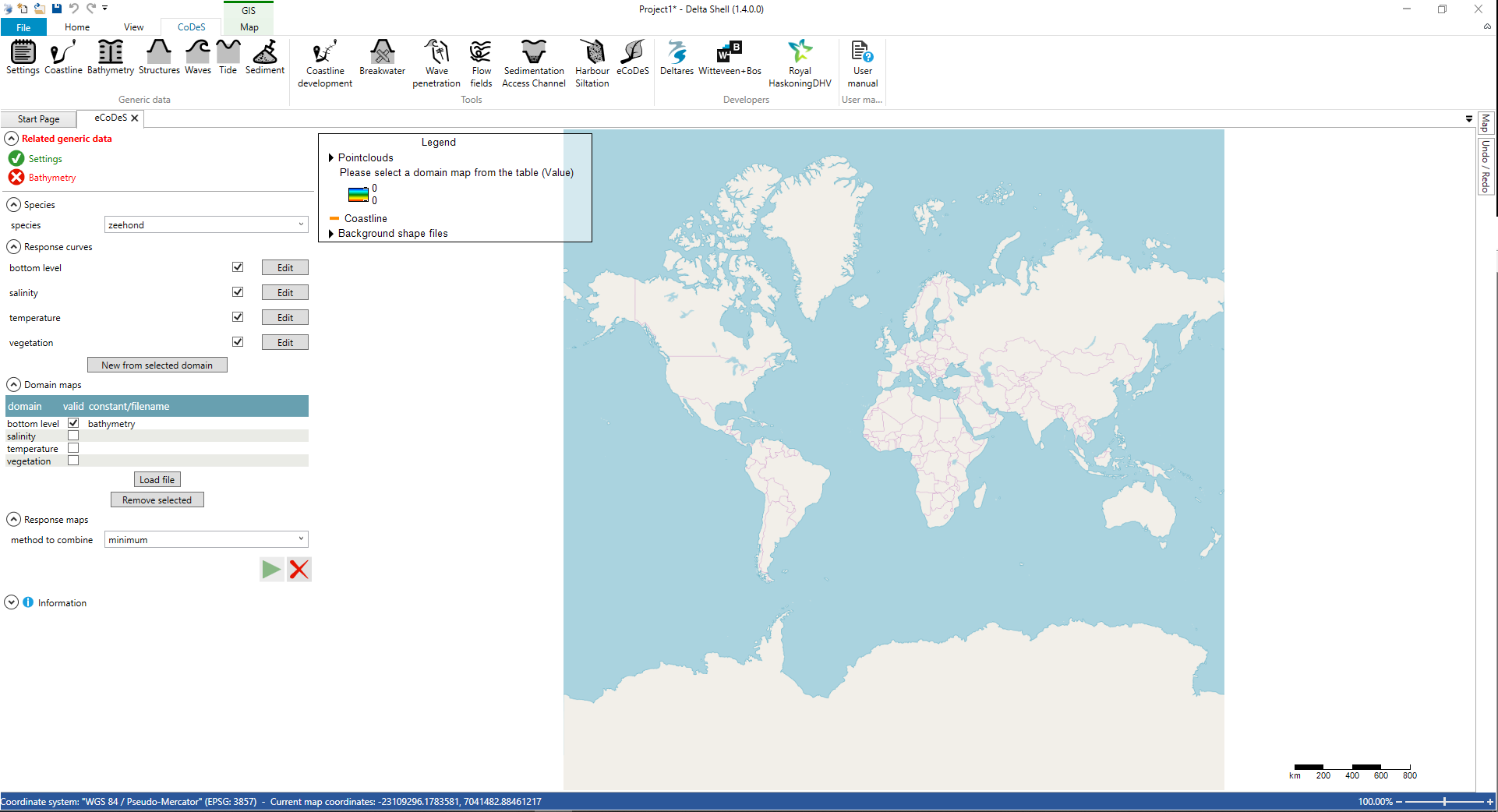...
Introduction
This tool can be used to calculate habitat suitability maps for selected species as a result of selected domains that it depends on. Response curves are used to calculate the response to the individual domain maps. These responses are combined to obtain the total response map.
The eCoDeS tool applies the principles that are used in the HABITAT tool. Though the main difference with the HABITAT tool is that eCoDeS also has the capability to use unstructured spatial data (point clouds).
eCoDeS can be used to conduct (ecological) assessments of availability and quality of habitats for species (groups) and results in a prediction of the habitat suitability index (HSI), presented in a response map.
Species response curves are a critical component of eCoDeS, as they describe the relation between a certain parameter and the HSI response map.
Many examples of species response curves can be found in the Ecological knowledge base of the HABITAT model.
compute the Habitat Suitability Index (HSI) in a response map for a selected species. The HSI is a non-dimensional index (ranging from 0 to 1), indicating the habitat suitability of a certain species (0 being 'not suitable at all' up to 1 being 'perfectly suitable'), which is presented spatially within the response map.
The HSI is computed through relations between domains (variables) and the selected species. These relations are stored in response curves, which are specific for each species and the domains (variables) it depends on.
The values associated with a domain (variable) are stored in a domain map, consisting of spatial information (a point cloud or single value in eCoDeS).
Upon calculating, a response map for the selected species is presented. If a species is dependent on multiple domains, the response curves are combined to obtain the total response map.
Glossary of terms
| Species | The species (or groups) for which the HSI is calculated. |
| Response curves | The relation between a species and a domain (variable). For example: A certain type of vegetation (species) which is dependent on water depth (domain/variable). |
| Domain map | Spatial information (point cloud) for a particular domain, e.g. water depth, salinity. |
| Response map | Spatial information (point cloud) of HSI [0-1], calculated by multiplying the domain map with the response curve. A response maps can also be used as a new domain map for chaining HSI's: e.g. vegetation is related to water depth; And a mussel is related to vegetation. |
| HSI | Habitat Suitability Index. An index ranging from 0 to 1, indicating the suitability of a species, as presented in a response map. |
Species response curves are a critical component of eCoDeS, as they describe the relation between a certain parameter and the HSI response map.
Many examples of species response curves can be found in the Ecological knowledge base of the HABITAT model.
The eCoDeS tool applies principles (explained above) that are also used in the HABITAT tool. Though the main difference with the HABITAT tool is that eCoDeS also has the capability to use unstructured spatial data (point clouds).
How to use the tool
To assess the habitat suitability index for a certain species, the following steps are needed:
...
Therefore, eCoDeS requires loading or defining a spatially varying bathymetry (either loaded as raster or point cloud data) in generic data. Find more information here.
Note: point-clouds with large amounts of points (>10.000 points) can be slow due to computational time.
An example of a loaded point cloud bathymetry of the Western Scheld region is shown below.
2. Load/create a species and associated response curves
...
In the table below, the recalculated response is shown for submerged vegetation, calculated with the values from the Ecological knowledge base of HABITAT, combined with a default water extinction coefficient k=1.
After pressing “keep changes”, the response curve is stored (also on your PC for later use) and you can close the response curve panel by clicking on the "X".
...
After pressing the calculate button the following screen appears:
The response map associated with submerged vegetation (considering water depth) is now shown on the map and appears under the “domain maps” panel.
...
Next, make a new species by typing “Otter” in the species panel. Now you can edit the response curves for “Otter” for domain maps “bottom level” and “submerged vegetation - bottom level” using the information in the Ecological Knowledge Base for the Otter, see the Figure below.
After creating the Otter and its response curves, the new HSI response map can be calculated using the calculate (play) button.
...
When using the “minimum” method, the results as presented in the Figure below are obtained for “Otter”.
Examples
No example is available (yet).
...





